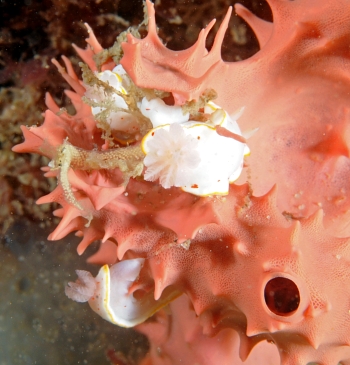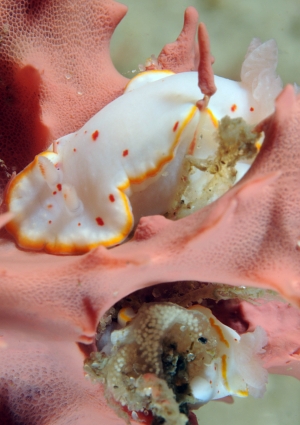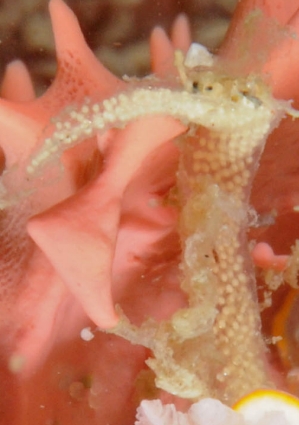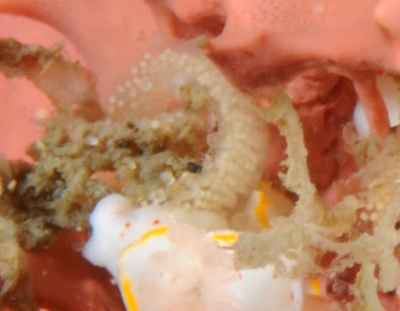Noumea haliclona egg ribbon
January 19, 2009
From: David and Leanne Atkinson

Concerning message #21925:
Hi Bill,
We found the New South Wales colour form of Noumea haliclona feeding on a pink sponge and laying eggs. Sadly we didn't see the eggs until we had the photos up on the computer screen so didn't angle our shots to get them. There are two individuals with eggs and there were five altogether on this sponge.We also have photos of them with their mouth extended onto the pink sponge but theought the egg shots were more interesting and although we can't see them being extruded one shot shows the egg string being shaped with the foot. The eggs seem consistent with the black and white photo of the egg string in your embryology page and the egg strings on an earlier group shot showing colour variations.
Locality: Fly Point, Port Stephens-Great Lakes Marine Park, Port Stephens , 12 metres, New South Wales, Australia, Pacific Ocean, 10 January 2009, Sandy bottom sponges, bryozoans, soft corals, hydroids, ascidians and kelp. Length: 10mm. Photographer: David and Leanne Atkinson.
Regards,
Leanne & David Atkinson
atk@hunterlink.net.au



Dear David & Leanne,
Thaks for these shots of the egg strings. I must finish the embryology pages you refer to - I need to add some explanatory notes. Noumea haliclona has direct developing eggs, which as we can see in your photos are relatively large, and lack a free-swimming veliger larvae stage, the hatchlings emerging from the egg capsules as small crawling slugs. The pink sponge, Darwinella gardineri, is one of the group of related sponges that this species feeds on.
You mention this is what I call the New South Wales colour form of the species. When I studied these animals from southeastern Australia I found, as is outlined on the main species Fact Sheet, that there were a number of distinct geographically distinct colour forms, all with what seems to be identical anatomy and reproductive biology. What links all the colour forms together is a red smudge on the front of each rhinophore. If you look at your middle left photo you can clearly see the red mark on each rhinophore.
Best wishes,
Bill Rudman
Related messages
-
Noumea haliclona & C. splendida feeding
From: L. & D. Atkinson, October 2, 2008 -
Noumea haliclona mating
From: Leanne & David Atkinson, September 23, 2005 -
Noumea haliclona from sthn Queensland
From: Gary Cobb, March 4, 2004 -
Noumea haliclona feeding in Nelson Bay
From: Dave Harasti, February 24, 2004 -
Noumea haliclona feeding
From: David & Leanne Atkinson, February 16, 2004 -
Noumea haliclona from Port Stephens
From: David & Leanne Atkinson, February 16, 2004
